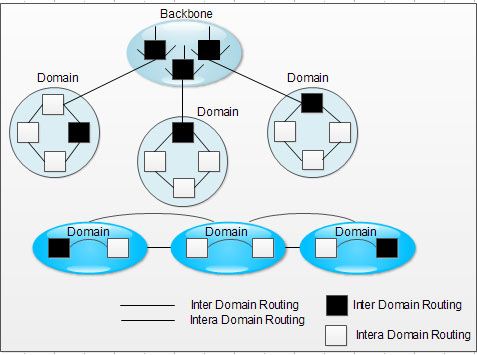Because of the global nature of Internet system, it becomes more difficult to centralize the system management and operation. For this reason, the system must be hierarchical such that it is organized into multiple levels with several group loops connected with one another at each level. Therefore, hierarchical routing is commonly used for such a system.

1. A set of networks interconnected by routers within a specific area using the same routing protocol is called domain.
2. Two or more domains may be further combined to form a higher-order domain.
3. A router within a specific domain is called intra-domain router. A router connecting domains is called inter-domain router.
4. A network composed of inter-domain routers is called backbone.
Each domain, which is also called operation domain, is a point where the system operation is divided into plural organizations in charge of operation. Domains are determined according to the territory occupied by each organization.
Routing protocol in such an Internet system can be broadly divided into two types:
- Intra-domain routing
- Inter-domain routing
Each of these protocols is hierarchically organized. For communication within a domain, only the former routing is used. However, both of them are used for communication between two or more domains.
In the following pages, we will look at description of Routing information Protocol (RIP), Open Shortest Path First (OSPF), and IS-IS, that are intra-domain protocols. RIP and OSPF will be covered later in detail.
Two algorithms, Distance-Vector Protocol and Link-State Protocol, are available to update contents of routing tables.
 Dinesh Thakur holds an B.C.A, MCDBA, MCSD certifications. Dinesh authors the hugely popular
Dinesh Thakur holds an B.C.A, MCDBA, MCSD certifications. Dinesh authors the hugely popular